Hey Dude! Like where's My Bike?!!!
By Steve Whitford

There's nothing like that sinking feeling you get when you discover that your favorite bike is no longer where you left it. Eventually it dawns on you that the odds of ever seeing your trusty good ‘ole bike again are slim to none. Sadly, here at South Shore Cyclery, we are always hearing stories about stolen bikes. This happens more often than you might think. Unfortunately, the world in which we live has some pretty unsavory characters who, for one reason or other, take things that don't belong to them.
But before I digress into everything that's wrong with this world, let's be realistic about what can be done to deal with the issue of bicycle theft.
Cyclists have a disadvantage with security issues compared to larger motorized vehicles. Bikes can be carried away, ridden away or vandalized more easily than cars. It's a sad story we hear way too often, "My bicycle was stolen"! Having been a victim of bicycle theft a few times, and knowing friends and family who have had similar experiences, I have become more cautious but also more pragmatic. Some people justify owning very "low-end" bikes or not riding at all by saying, "It would only just get stolen." However, if you are realistic about the application and the situation you can significantly minimize the chance of theft.
Often criminals are not the brightest folks and it may not take as much as you think to discourage them from messing with your ride. Where you leave what kind of bike for how long and how paranoid you are may dictate how you approach bicycle security.
What to Use & When
There are many different styles and levels of protection offered when choosing a bicycle locking system. Some will be adequate for a quick stop while running into a store, but may not be the best choice for leaving the bike unattended for extended periods.
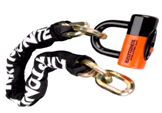 Kryptonite New York Chain & Lock
Kryptonite New York Chain & Lock
Extremely durable locks can sometimes be heavy to carry and may not be as flexible or easy to use. Some bike lock manufacturers have a rating system to let you know what level of protection and strength their locks offer at different price points. Some manufacturers even offer anti-theft guarantee insurance in different dollar amounts depending on the lock you buy.
Many cable locks can be cut by a bolt cutter. Braided cables tend to squash before they are cut through and larger diameter or cables coated with armor are less likely to be cut without the use of power tools. More "entry-level" "U"-shaped locks can sometimes be beaten with a hammer until they pop open. Stronger "U"-locks are case-hardened to help prevent cutting attacks while others offer locking mechanisms that engage on both sides instead of just one. In general, larger diameter cables and "U"-locks are harder to get through.
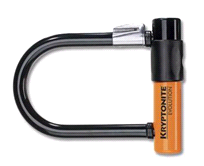 Kryptonite Evolution Mini
Kryptonite Evolution Mini
There are also a number of chain locks that offer the flexibility of a cable but with the strength closer to a "U"-lock. These typically have "squared" and or hardened links that prevent bolt cutter jaws from getting a grip on them. It's also a good idea to be sure that the lock you're using is coated with cloth or plastic so it does not scratch the paint on your bike either while riding or when it is secured. The obvious drawback of a bulky heavy yet sturdy lock is that it's not fun to transport when biking around. This is why some lock manufacturers are making mini-U-locks that are smaller, lighter, and just as strong, though not as flexible to use. Some commuters opt to leave their heavy lock attached to a landmark where they lock-up at work. That way they don't have to carry it to and fro every day.
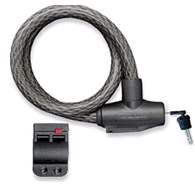 Planet Bike Heavy Duty Cable Lock
Planet Bike Heavy Duty Cable Lock
Where you park and or the value of your bike may determine how you lock it up and what kind of lock you might use. Whether you have a "garage-sale-special" or a "feather-weight race rocket" you surely don't want to lose your bike and the convenience it provides. Unfortunately, some thieves are inclined to target more expensive or cleaner shinier machines. Some riders will even "uglify", their bikes making them look unattractive on purpose so they don't draw the attention of would-be thieves. Often it's a good idea to lock your bike in a well lit trafficked area than in a back-alley where no one might notice or even hear the lock being attacked. Keeping the bike within sight when possible is a good idea, especially if you're using a smaller cable lock. Make sure you attach and lock to something secure, sturdy, and not near places other vehicles could bump into it. Smaller trees or poles with no signs are not ideal as your bike could be slid up and over them. Additionally, the pole or the tree, if not sturdy, could be cut. Also, try to lock your bike so it will stay upright, that way no hooligans can tip it on its side and bend it up, like my poor Takara. Even if your bike is in a fenced in area be sure it is locked; thieves can climb. There are many schools of thought about bicycle security, but being overly cautious just might insure that your faithful bike is there when you return for it.
Other Stuff
Bikes get stolen way too often but sometimes we hear about components or accessories being stolen as well. Wheels and seats sometimes have quick-release levers to allow ease of removal and adjustment. While this may be a nice and convenient it is also theft risk.
Wheels
There are a few options to secure wheels that have quick-release systems. Some replacement skewers offer Allen wren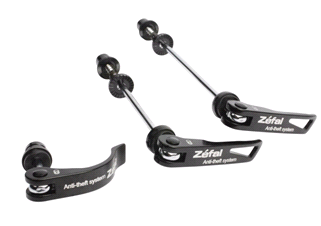 ch bolts which require an Allen wrench to remove them. The Allen wrench is small and easy to carry with you in case you need to remove a wheel. However, if a thief has a set of these wrenches you may still get ripped-off. A different kind of wheel lock skewer has a unique wrench that comes in the kit; sort of like a "key". Nobody with regular tools would be able to take these off. Recently a new skewer, which works in the same manner as standard skewer, allows for wheel removal only when the bike is upside down. Therefore if it's locked right side up no one can open the quick release levers.
ch bolts which require an Allen wrench to remove them. The Allen wrench is small and easy to carry with you in case you need to remove a wheel. However, if a thief has a set of these wrenches you may still get ripped-off. A different kind of wheel lock skewer has a unique wrench that comes in the kit; sort of like a "key". Nobody with regular tools would be able to take these off. Recently a new skewer, which works in the same manner as standard skewer, allows for wheel removal only when the bike is upside down. Therefore if it's locked right side up no one can open the quick release levers.
Zefal Anti-Theft Skewers
Seats & Seat Posts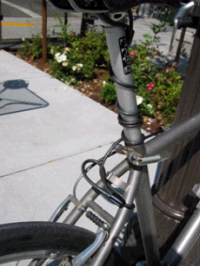
Seat post diameters are all "over the map" so the likelihood of one post working on another bike is slim. Even though this is the case, bikes with quick release seat post clamps are still at risk of seat theft. And many of the nicer seats can get pretty expensive. Often we can replace a quick release seat binder clamp with a bolt which provides a more theft-proof system. For those who still like the adjustability of the quick-release we sell a "seat-leash" that is looped around the frame and then clamped between the saddle rails. This allows tool-free adjustment of the seat height yet the seat and post cannot be removed without tools.
Seat Leash in use.
Etc.
Most bags, lights, computer head units and other accessories can be removed easily and taken with you. It can be annoying to have to take your accessories off when parking your bike but it's the best way to make sure no one walks off with them. In any event, never leave valuables behind like your wallet, cell phone, etc. in any bag of your bike when parked. You are only asking for trouble.
Summary
While we live in a world where we have to expect and live with theft and vandalism we can always take preventive measures to lessen our exposure to this risk. Utilizing the right security option for a given circumstance will help you keep your bike out of harms way.
If you have any questions about bicycle security or product information do not hesitate to call me at the shop or email me at: steve.w@southshorecyclery.com
And always remember; "To be forewarned is to be forearmed".
Steve
The bicycle tire is an important component of cycling that is often overlooked or "over-thought". A bicycle tire has a pretty demanding job when you think about it. It has to provide traction, be durable, last a reasonably long time, and resist abrasions as well as punctures. Cyclers often find it overwhelming when they discover how many available options there are including style, material, size, and even color. Bicycle tires can cost less than a pizza or considerably more than a car tire and last only a few hundred yards or thousands of miles.
Proper Tire Maintenance
So let's talk just a little about proper tire "care and feeding". First, for best results, match the tire to the application (see link below) and then (and this is important!) maintain it properly. A big factor in preventing flats, extending tire life, and increasing peddling efficiency is proper inflation. Bicycle tires are not like car tires. Bicycle tires have an "inner tube" and are more porous, so they will need frequent inflation. Depending on the size and pressure of a tire, you may have to add air for every ride or possibly only once a week. Some tires behave differently but checking them often will give you a good idea about the frequency of inflation your bicycle tires will need.
Tires that are too low on air pressure will produce more friction and thus make you pedal harder. Further, they will be more prone to get a flat. Typically, tires will have their correct pressure range as well as the tire size printed or molded onto the side-wall of the tire. Once again, how you ride, where you ride as well as rider weight will help determine what pressure to use in a given pressure range. Over inflation is also a problem to be avoided as it can result in a flat as the casing of the tire is only strong enough to handle the max inflation of the tire. Lower tire pressure can help with traction and shock absorption but often adds to rolling resistance causing less efficiency and possibly more chance of flats. Higher pressures generally lead to a more efficient faster rolling tire but less shock absorbing properties.
(TIP-TIME: Okay, here is a tip that Scott asked me to put in the article. This is what he calls an "Old-Timers-Tip" for those whose memory and eyesight are not what they used to be. So Scott says:
"I can never seem to remember the correct pressure for each of my bicycles, so I take a black Sharpie marker and write it somewhere on the fork of the frame. And in pretty large size too so I can see it without my reading glasses which I would need if I have to read the sidewall of the tire. If you have reservations about writing on your nice bike, then simply put a piece of clear plastic carton tape over the area first and write the number on the tape. This may look a little funky but it sure saves time and frustration.")
Off-Season Storage
Unless you are going to regularly check your bicycle tire pressure during the winter months you should not just let the bicycle sit in storage with all its weight on the tires. This will inevitably lead to side wall break-down. It is best to either take the wheels off the bicycle & store separately or hang the bike upside down on special bicycle hooks or "block-up" the bike to remove weight from the tires.
Inner-Tubes & Valves
And then there are those pesky inner-tubes. Inner-tubes will come with one of two different types of valves. They are known as the Schrader valve (like an auto tire valve) and the Presta valve, which is smaller in diameter and may require an adapter to work with certain pumps. Its smaller diameter requires a smaller hole to be cut in the rim thus resulting in greater strength. Most quality bicycle air pumps will accommodate both types of valves without any adapters. If you have an older, still functional pump, you can obtain a special adapter for the presta valve inner-tube that will let you fill it up with a standard schrader pump head.

Tires Sizes, Composition, etc.
Tire width plays an important factor in determining what kind of ride you will experience. Wider tires will provide more shock absorption but add rolling resistance whereas narrow tires will give you faster ride but provide much less shock absorption. What a lot of people don’t know is that most wheels allow for a range of different tire widths. However, sometimes the width will be limited due to rim size, frame dimensions, and brake clearance.
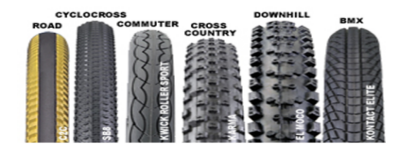
When you read a tire size on the side wall of the tire, the first dimension is the wheel size (i.e. 26", 27", 700c, etc) and the second is the width of the tire. Additionally, tires may have differences in tread and material. Some tires have a softer "grippier" composition while others are harder and longer lasting but not as "grippy". Off-road tires come in a myriad of styles patterns and sizes with knobs and tread pattered in many different configurations. Some new MTB tires have inverted tread or "voids" in the pattern instead of knobs sticking out. Some tires have knobs spaced further apart such that rolling resistance is lessened. The casing can have a higher thread count for a stronger or higher pressure tire. Many tires also have Kevlar-type materials or a harder inner casing that is more puncture resistant causing fewer flat tires. A lighter tire will be faster rolling but may not always last as long or be as puncture resistant. Some tire companies boast that their tires excel at all of the above but usually at a higher cost. The thickness and material used for the sidewall can also affect the ride of the tire.
Besides tire pressure, a simple inspection of your tires periodically for wear and debris will help keep you from breaking down. Often small pieces of glass and metal will be picked up by a tire but it will not always cut through and cause a flat right away. If it is removed before it gets through to the tube you might just prevent a flat.
For the most part, wheels are available in a few standard sizes. In the past some manufacturers like "Schwinn" made tire sizes that were proprietary. Some riders still use the old style tubular tires (known as sew-ups) where the tube is actually sewn with needle and thread into the tire and then the "tube-shaped" tire is glued to the rim with special rim cement. These tires are still available but have a rim style that is different than modern standards.
It is important to use the correct size inner-tube for the tire you are using. Most inner-tubes are sized such that they can be used for a range of tire widths. (i.e. 26 x 1.75 thru 2.125"). More recent tire and tube innovations include:
- ¨ Tubeless road and mountain bike tires.
- ¨ Lighter and superior "self-healing" tire sealants.
- ¨ Reflective tire compositions
- ¨ 29er (Sometimes referred inaccurately as 29" wheels) larger wheeled mountain bike tires.
- ¨ Resurfacing of the 650b tire size...
The intention of this article is simply to cover some of the basics of the modern bicycle tire. If you have any questions please do not hesitate to stop-by the shop (or email me at steve.w@southshorecyclery.com) and we will be happy to help answer any additional questions you may have.
"Basics of the Bicycle Derailleur"
The Derailleur is the heart of the bicycle transmission system and has been around since the beginning of time. Okay not really before time, but long enough for it to thoroughly confuse some people and frustrate countless others. In fact the bicycle derailleur has been in use in one form or another since the beginning of the 20th century. When properly adjusted, lubricated and aligned a derailleur in good condition will function surprisingly well in light of the fact that they shift by effectively forcing the chain from gear to gear, without any sort of clutch to alleviate pressure on the system.
They come in different shapes configurations and varieties, some look like high end shiny kitchen devices while others look like angry robots. In the end they all use some form of the original technology that guides the chain from cog to cog and allows the chain length to adjust accordingly.
Modern derailleur systems have much improved on the original designs but need similar regular maintenance. Most of the pivots and guide wheels have bushings instead of bearings; some of the high end models are self lubricating or have materials that need less lubrication. For the rest, a drop of oil on each pivot point will keep them smooth and operational. With index shifting the cable tension has to be correct to ensure that each "click" will place the chain on the right cog properly.
Cables can stretch causing the wire tension to change sometimes throwing the shifting out of adjustment. Worn or improperly lubricated cables and chains can also cause shifting issues. If the hanger the derailleur mounts to, or the rear drop out of the bicycle frame is slightly bent the whole system can be affected. It's important not to drop or lay your bicycle on its drive side to ensure the rear derailleur alignment is not compromised. If the hanger or drop out is bent we have a special tool to realign it parallel with plane of the rim. Whether your new to them or can remember when they first "hit the scene", derailleur's are still the transmission device common on many bicycles.
If you want to know more about the history and technology of the bicycle derailleur, click here for a nice article on Wikipedia which you may find interesting.
All about Chains
“As the Chain Drags”: Brush your teeth, Clean your chain, How worn out is your Drivetrain?
A worn out chain or worn teeth on your gears can cause dangerous and poor performance from your bike. Routine maintenance, inspection and replacement of worn parts can ensure quality performance longevity and safe functioning of your bike. Keeping the crankset, cassette and chain clean as well as lubed will help will extend the life of these sometimes costly parts. Stop in anytime and we can let you know how much life is left in your chain.
How Long Should they Last?
- 9-speed chains should last 2000 to 2500 miles
- 10-speed chains should get you 1500-2000 miles before causing serious wear on rear cogs and chain rings, assuming they're not totally “gunked-up”
- Off-road riding can cut that mileage in half or less. Some manage to wear out chains in under 500 miles.
Other Factors That Reduce Chain Life:
- Gunked up. Dirt & grit act like sandpaper and wear down the rollers.
- Rider weight
- Riding in the hills
- Example: A rider weighs 175 lbs & rides nothing but climbs. That rider could have to replace a chain at about 1800 miles and consume 5 chains to one cassette.
Benefits of a NEW Chain:
- Crisp & Lively Shifting
- Efficient Pedaling
- Longer Life of “Pricy” drive-train parts
- Less Grease on you local bicycle mechanic J
- No Grease “Tattoo” on your right inner leg
Tip- Worn chains and cogs cause the chain to skip over the teeth, especially when pedaling with lots of load. It could be dangerous to ride a bike with a worn drive train, but if you must ride a worn drive train, do not pedal hard or out of the seat and stay in rear cogs that are larger, these tend to wear and skip less since they have fewer teeth and a less radical angle.
